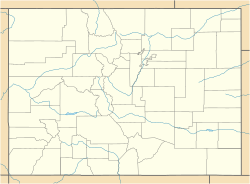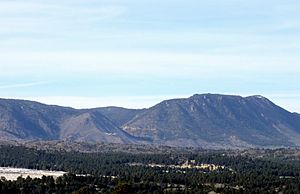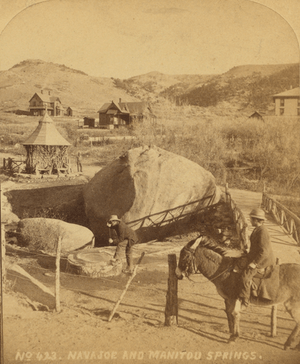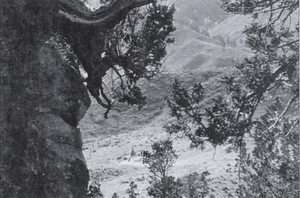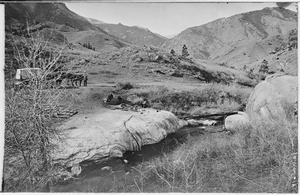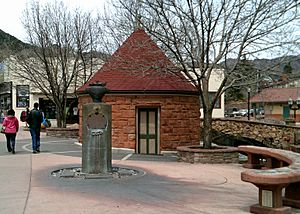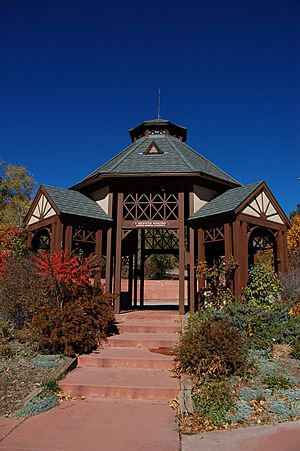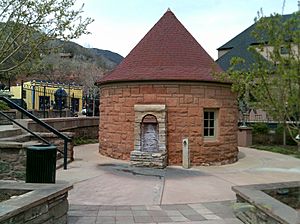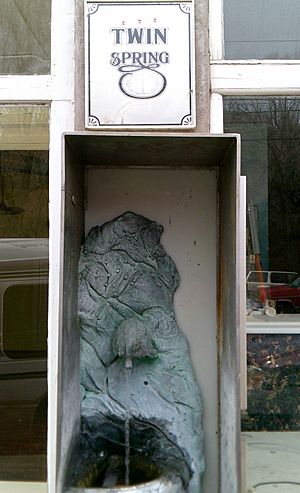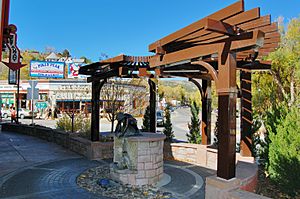Manitou Mineral Springs facts for kids
Quick facts for kids |
|
|
Manitou Springs Historic District
|
|
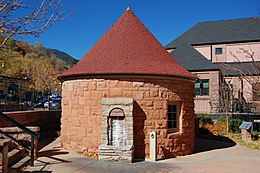
Shoshone Spring, Manitou Avenue
|
|
| Location | Manitou Springs, Colorado |
|---|---|
| NRHP reference No. | 83003516 |
| Added to NRHP | 1983 |
Manitou Mineral Springs are natural springs found in Manitou Springs, Colorado. The Cheyenne Spring House, one of the buildings here, is listed on the National Register of Historic Places. These springs are part of one of the biggest historic areas in the United States.
Contents
Discovering Manitou Springs
Manitou Springs is often called the "Saratoga of the West." It was created as a special place for people to visit and relax. The town is famous for its mineral springs and its amazing location. It sits right at the edge of the Rocky Mountains and at the base of Pikes Peak.
How the Springs Work: Geology
The water in Manitou Springs comes from two main places. One source is "deep-seated waters" from the Rampart Range and Ute Pass. This water flows through underground cave systems called karst aquifers. As the water moves, it dissolves limestone, which creates carbonic acid, or carbon dioxide. This is what makes the water "bubbly." The water then rises to the surface naturally. This process is called an artesian process. As the water travels through rock layers, it picks up minerals and soda, also known as sodium bicarbonate.
Some of the spring water also comes from "surface" waters. These are from the areas where water collects for Fountain Creek and Williams Canyon. Each spring has different minerals in it. This is why each spring tastes a little different!
History of the Sacred Springs
The town has many mineral springs. Native Americans called them manitou, which means the "breath of the Great Spirit Manitou." They believed this spirit created the bubbles in the spring water. The springs were considered sacred places. Native Americans drank and bathed in the mineral water to feel better and heal. Tribes like the Ute, Arapaho, and Cheyenne came to this area. They spent winters here and "shared in the gifts of the waters without worry of conflict." There were originally about 9 or 10 natural springs.
As more white settlers arrived, there were conflicts over who could use these special springs. Eventually, Native Americans were moved to reservations.
In 1820, explorer Stephen Harriman Long wrote about the water's healing powers. Edwin James, a scientist on his trip, also noted the water's health benefits. He was also the first European man believed to have climbed Pikes Peak. George Frederick Ruxton wrote about the "boiling waters" in a book about his travels. He understood how sacred the site was to Native Americans. Ruxton wrote that the spring's basin was "filled with beads and wampum, and pieces of red cloth and knives." He also noted that nearby trees were "hung with strips of deer skin, cloth and moccosons (sic)."
Forty-eight years later, a plan for a health resort was created. Dr. William Abraham Bell and William Jackson Palmer, a general from the Civil War, had a dream. They imagined beautiful summer homes in the mountains. They also pictured grand hotels and parks around the springs.
Railroad travel brought many people to the area. It was first called Fountain Colony and La Font. The town didn't quite turn out as the two men first imagined. Instead, shops and homes were built. It became the first resort town in Colorado.
In 1873, Henry McAllister, a developer, praised the health benefits of the springs. He said Manitou Springs had everything needed for a successful spa resort. This included "incomparable climate and scenery."
Doctors like Edwin Solly promoted the health benefits of the "pure air" and sunny Rocky Mountain climate. He called it the "world's best suited therapeutic environment" for treating tuberculosis. He also believed in the benefits of the mineral spring water. This brought many tourists and sick people, especially those with tuberculosis, to the area.
As the town grew, some springs were covered by buildings. One of these covers, made of red sandstone with a cone-shaped roof, is the Cheyenne Spring House. After 1900, there were more than 50 drilled wells and springs. Over time, more were covered.
The town's popularity later decreased, and some springs were closed or paved over. Then, in 1987, the Mineral Springs Foundation was started. Its goal was to bring some of the springs back to life. They also wanted to promote the benefits of the town's spring water. Today, you can take "Springabouts," which are walking tours of the town's springs.
Manitou Springs water was even sold all over the world!
Exploring the Springs
7 Minute Spring
The 7 Minute Spring was drilled in 1909 near the old Manitou House Hotel. Every 7 minutes, a geyser would shoot up. In 1993, a park was built around a new spring that was drilled. Don Green, Maxine Green, and Bill Burgess worked together to create two water spouts at the spring.
Cheyenne Spring House
The Cheyenne Spring House was built in the 1890s using red sandstone. It is a soda spring. Like the Navajo Spring, it has a lot of minerals overall. However, it doesn't have a very high amount of any one specific mineral. The Manitou Mineral Water company built the structure. Its sweet water comes from limestone aquifers that are thought to be over 20,000 years old. These are located about one mile underground. You can get water from this spring from a bronze sculpture by Paul Rogers, which is a few feet from the spring house.
Iron Spring Geyser
The Iron Spring Geyser was drilled on Ruxton Avenue in 1910. Joseph Hiestand drilled it to make more iron-rich mineral water available in town. This type of water is also called chalybeate water. The spring water also has a lot of fluoride, silica, sodium, and potassium. In the 1880s, people looking for better health would stop at this spring during their daily walks.
This spring used to erupt every 45 minutes, shooting water up to 7 feet high. It was located in the Navajo Geyser Pavilion. The spring is privately owned and was fixed up in 2006. However, it stopped flowing in later years. There is now no sign of the spring in the Manitou Outpost store building. The spring was plugged, and a sidewalk was paved over it. Later, the spring was changed into the hand pump you see today.
Native Americans and early settlers came to the Navajo Spring along the Ute Trail. They believed its water had healing powers. This spring's water was used for the local bathhouse. It was also the source for bottled spring water sold as "Ginger Champagne" and "Manitou Table Water." The water generally has a high mineral content. However, it doesn't have an extremely high level of any single mineral. The spring's water spout, designed by Chris Dysart, is located behind Patsy's popcorn kiosk on Manitou Avenue.
Shoshone Spring
The Shoshone Spring's spring house was built in the 1890s on Manitou Avenue. It has the most "deep-seated water" from the karst aquifer system. It also has the highest mineral content of all the town's springs. It is especially high in chloride, calcium, alkalinity, lithium, manganese, and zinc. Because of its high mineral content, it was thought to be the most "medicinal" of Manitou's springs. This was partly due to its sulfur content. The spring house was built using red sandstone from the nearby Kenmuir Quarry. That quarry is now the Red Rock Canyon Open Space.
Soda Spring
Soda Spring is one of the natural springs in Manitou Springs. It was once in an open-air building. Now, the spring is located in the basement of the Spa building.
Stratton Spring
Stratton Spring is named after Winfield Scott Stratton. It was drilled in 1936 by the Stratton Foundation. You can find it at "the loop," which is a circular intersection at the end of Manitou Avenue. This was where the avenue's railroad car line ended in the early 1900s. A sculpture created by Fred Darpino is located at the site.
Twin Spring
Located on Ruxton Avenue, Twin Spring combines water from two different depths. The water flows from one spout. The spring was once called Twin Lithia Springs because it contains Lithium. The water, which is high in magnesium, is considered "sweet" water. Locals use it to make lemonade. Besides its pleasing taste, it is also valued for its potassium and calcium content. William S. Crosby drilled this spring in the 1920s.
Ute Chief Spring
This spring is located at the far western end of Manitou Avenue and is privately owned. A sculpture by Steve Titus, showing a Native American man, represents how advertising sculptures were used around town. These sculptures promoted bottled Ute Chief Mineral Water. The metal sculpture is a copy of an original plaster sculpture that was on the site in the first half of the 1900s. The Ute Chief Spring no longer flows.
Wheeler Spring
The Wheeler Spring was drilled in 1920 by the son-in-law of Jerome B. Wheeler. Wheeler was an investor in Aspen and Manitou Springs, Colorado. He created the Manitou Mineral Water bottling plant and built the Wheeler Clock on Manitou Avenue. (He also built the Hotel Jerome in Aspen.) The spring is located near where his home, Windemere, used to be. The United States Post Office is now in that spot.


